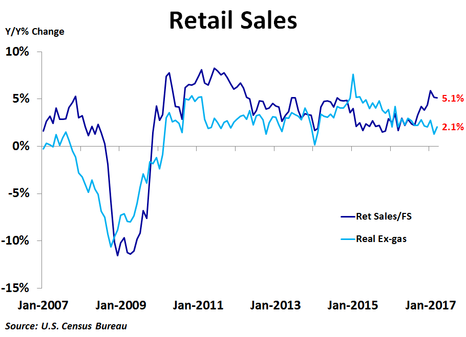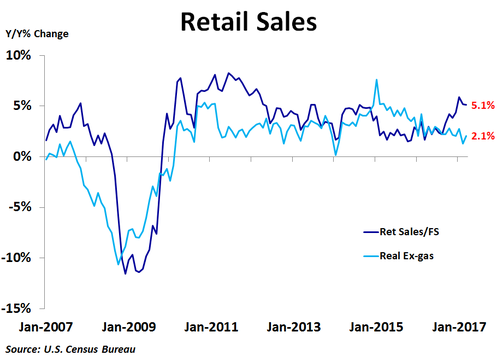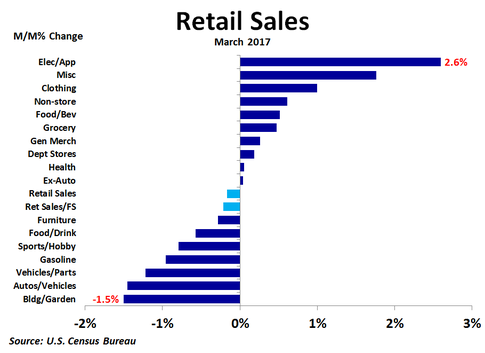Retail sales fell 0.2% in March from the prior month, missing the consensus forecast of no change, following a 0.1% increase in February. Sales excluding autos were unexpectedly flat, while sales excluding autos and gas rose 0.1%, also less than expected. On a year-over-year basis, sales were up 5.1%, down slightly from February’s 5.2% pace.
Food and beverage sales rose the most in dollars from the prior month, increasing by $308 million, or 0.5%. Non-store sales came in a close second, rising by $302 million, as purchasing online continues to be a more common way to shop. Grocery sales followed with a $254 million increase. Electronics and appliances led the way on a percentage basis, as sales rose $212 million, or 2.6%. Strength was also seen in miscellaneous goods (+1.8%) and clothing (+1.0%). The biggest decline in dollars came from vehicle sales, which plunged by $1.3 billion, or 1.5%. Building and garden supply sales followed with a $474 million, 1.5%, decline, while gasoline sales fell by $354 million, or 1.0%. These percentage declines were also the largest of all of the categories.
Sales were higher on a year-over-year basis, led by a $5.4 billion, or 12.3%, increase in non-store sales. Vehicle sales were a close second with a $5.3 billion, or 6.4%, rise in sales, followed by a $4.4 billion, or 13.7%, increase in gasoline station sales . Thus, while lower vehicle and gasoline sales were major factors in weak overall sales in March, they were big factors in the year-ago comparisons. The largest dollar decline in sales was seen in department stores, where sales were down $620 million, or 4.7%, which was also the biggest percentage decline.
Sales were higher on a year-over-year basis, led by a $5.4 billion, or 12.3%, increase in non-store sales. Vehicle sales were a close second with a $5.3 billion, or 6.4%, rise in sales, followed by a $4.4 billion, or 13.7%, increase in gasoline station sales . Thus, while lower vehicle and gasoline sales were major factors in weak overall sales in March, they were big factors in the year-ago comparisons. The largest dollar decline in sales was seen in department stores, where sales were down $620 million, or 4.7%, which was also the biggest percentage decline.
If we take out the impact of gasoline sales, which are not really an indication of stronger or weaker economic growth but rather due to changing gas prices, ex-gas retail sales were up only 4.5% from a year ago in March. If we also adjust for inflation, we see that real ex-gas retail sales were up 2.1% in March, a nice rebound from February’s moribund 1.3% growth rate. This measure of retail sales growth, which went negative a year before the headline number leading up to the Great Recession, has been trending down over the last two years. Unfortunately, March’s rebound was not enough to break that trend.
This report, along with the unexpected decline in consumer prices in March, may give the Fed some pause at its next rate setting meeting in May. Weak March data suggests a rate increase is less likely than a few weeks ago.
This report, along with the unexpected decline in consumer prices in March, may give the Fed some pause at its next rate setting meeting in May. Weak March data suggests a rate increase is less likely than a few weeks ago.



 RSS Feed
RSS Feed